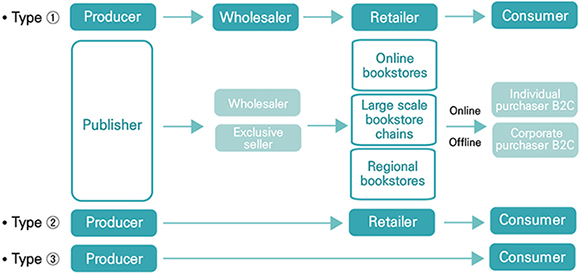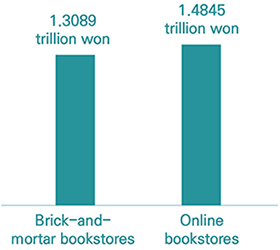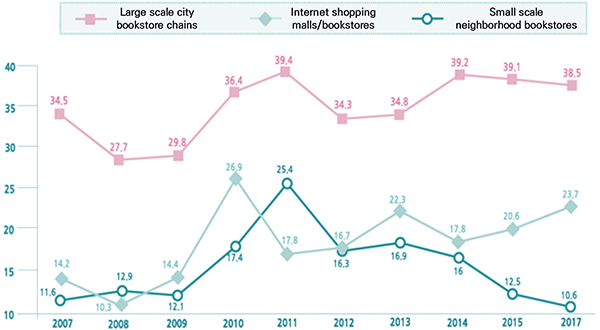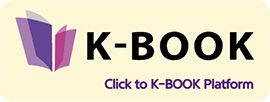|
South Korea's publishing market and distribution structure
2019.12.09
South Korea's publishing market can be divided into three categories: book publishing (paper media publishing), educational publishing (textbooks and educational material publishing) and internet/mobile digital publishing and production. When taken as a whole, publishing sales stood at 4.0078 trillion won in 2010 and rose 8.2 percent to 4.3388 trillion won in 2017, showing an average growth of 1.1 percent each year in between. A characteristic of South Korea's publishing market is that educational content accounts for a huge piece of it. From 2010 to 2017, educational publishing has seen an average 1.8 percent in growth while paper book sales have seen an average decline of 2.6 percent over the same period. Meanwhile, e-books have seen sharp growth, with sales jumping 17 percent on average each year from 2010 to 2017.
A characteristic of South Korea's publishing market is that educational content accounts for a huge piece of it.
Companies like Woongjin Thinkbig, Daegyo, Visang Education and Neungyule that are in the educational publishing industry sell their publications in bookstores through regional distributors who have received rights to sell in specific regions from the publishers. In the case of regular books, third party logistics specifically meant for publications are used to directly supply books for online bookstores, large chain bookstores and regional mid-sized bookstores. Distributors include nationwide wholesalers (Booxen, Interpark Songin Books, Bookplus) and regional wholesalers. Distribution through wholesalers has been on a decline as regional bookstores have seen their market share shrink on aggregate. Retailers can be divided into three channels: online bookstores (YES24, Kyobo Book Centre, Aladin, Interpark), large scale chains (Kyobo Book Centre, Youngpoong Bookstore and Seoul Bookstore), and regional bookstores. In 2018, more than 80,000 new books were released from roughly 8,000 publishers. From about 2,000 brick-and-mortar bookstores, 85 are for large scale bookstore chains and online bookstore Aladin operated 45 locations for secondhand books. Recently the importance of membership business has grown amid publishers directly marketing and selling to consumers obtained through social media channels. The below flow chart shows the three types of publication distribution processes in South Korea:
Distribution structure of publications
Another characteristic of South Korea's publication distribution structure would be consignment sales. Publishers provide books for bookstores to sell, later collect profits from sold publications and buy back books that fail to sell. Online bookstores have transaction structures that are usually based on orders, while the distribution of new books through large scale chains or regional bookstores use a combination of consignment sales by distributing first edition copies and order-based transactions. Consignment sales have proven somewhat problematic as sales profits are at times not transparently taken from bookstores and return rates of unsold books can be high.
South Korea has a fixed price system in place for books. Despite this fact, online bookstores take up a large share of distribution channels. Recently, the size of sales through online bookstores surpassed those of brick-and-mortar bookstores. According to “2018 Publishing Industry Survey”, the retail book industry was worth 2.7945 trillion won in 2017 and among this, online stores accounted for 1.4845 trillion won (53.1 percent) while brick-and-mortar bookstores accounted for 1.3089 trillion won (46.9 percent). The biggest portion of transaction clients for publishers was constituted by online bookstores at 22.2 percent while the proportion of large scale bookstore chains stood at 18.0 percent. Direct sales by publishers were 13.4 percent, wholesalers/exclusive sellers 12.6 percent and institution sales were 12.1 percent.
Distribution channel sales portions divided between South Korea's brick-and-mortar bookstores and online bookstores (2017)
Bookstores are no longer simply places where books are sold and bought, but spaces that sell diverse experiences with books as a medium
As consumer culture trends change, large scale bookstore chains and independent bookstores that have brick-and-mortar stores have been attempting to expand their service offerings based on consumer needs. This is because bookstores are no longer simply places where books are sold and bought, but spaces that sell diverse experiences with books as a medium. They are being required to transform into comprehensive cultural spaces and lifestyle goods stores. Recently, new types of independent bookstores have become popular thanks to social media, but they are having trouble staying open due to sluggish book sales. The stores themselves become well-known through traditional media and social media, but actual book sales have been too low that the stores have been unable to make any impact on publication distribution channels as locations for book sales. The aforementioned survey has shown 38.5 percent of adult consumers prefer to buy books at large scale chains, 23.7 percent at online bookstores and 10.6 percent at regional and neighborhood bookstores. The changes in bookstore usage can be referenced in the chart below.
Changes in book distribution channels mainly used by South Korean adults (2007 to 2017)
Publishers have also been trying their hand at directly marketing and selling books to readers using membership business strategies. This would include podcasts, Youtube channels and mobile book clubs. Readers have also shown changes in their buying patterns by gaining information on books from Youtube and social media, reading them online and later purchasing them in paper format if they truly like the books. Readers who use online bookstores have quickly been moving from PC to mobile, and more than 50 percent of sales at online bookstores are now made through mobile apps.
The e-book market has been growing on the back of expansions in periodical downloads and subscription services. The growth rate of the e-book distribution market has been sharp, but e-books only account for 5 percent of South Korea's entire publishing market. The e-book market, including web novels, is estimated to be worth around 400 billion won. In the case of Ridibooks, which is the biggest seller of e-books in South Korea, the business has seen an average 40 percent growth every year for the past 3 years. Recently, Ridibooks has seen sales around 100 billion won after launching its monthly subscription service called RIDI Select, which brought in an influx of new users. Companies like Kyobo Book Centre, Korea E-Pub and Millie's Library provide e-books mostly comprised of novels. Serially published web novels dealing with fantasy, martial arts and romance along with 'snack-culture' web content developed for mobile devices are leading the growth seen in the e-publication market, and these are usually serviced through major online portal platforms like Naver and Kakao. Interest in audiobooks has grown greatly as well, and attempts at creating audiobooks using Naver's voice synthesizing technology using the voices of famous people has been garnering public interest.
Various platforms for e-book distribution
〈RIDI Select〉 https://select.ridibooks.com
Written by Choi Sung-gu (Head of team at Book Trade Promotion) Choi Sung-gu (Head of team at Book Trade Promotion) |
Pre Megazine
-

New Tarot Made With Korean Colors and Patterns!
VOL.69
2024.04 -

Please Look After Mom by Shin Kyung-sook
VOL.69
2024.04 -

Paper Play – A Great Way for Emotional Development, Concentration, and Creativity!
VOL.68
2024.03 -

Submit Us Your Reviews of Korean Books!
VOL.68
2024.03 -

A Miraculous Workout Routine for a Healthier Body!
VOL.67
2024.02 -

The Hottest Place in Korea, Right Here, Right Now!
VOL.66
2024.01 -

Kim Jiyoung, Born 1982 by Cho Nam-Joo
VOL.66
2024.01 -

Concerning My Daughter by Kim Hye-jin
VOL.65
2023.12 -

Bake Delicious Bread that’s Just Right for Your Taste
VOL.65
2023.12 -

Craft Your Own Special Miniature Furniture
VOL.64
2023.11 -

Take Beautiful Palace Tours With a Book
VOL.63
2023.10 -

A Guide to Beautiful Korean Handwriting
VOL.62
2023.09 -

An Offbeat Trip to Jeju Island
VOL.61
2023.08 -

Prepare for Disasters with a Single Book
VOL.60
2023.07 -

The Hen Who Dreamed She Could Fly by Hwang Sun-mi
VOL.60
2023.07 -

Feel the Street Vibes with Watercolor Painting
VOL.59
2023.06 -

Bone Soup by Kim Young-tak
VOL.59
2023.06 -

Eat Healthier and Tastier – Korean Vegan Food
VOL.58
2023.05 -

Almond by Won-pyung Sohn
VOL.58
2023.05 -

Learn About and Have Greater Fun Drinking Korean Alcohol!
VOL.57
2023.04 -

Knitting YouTuber Daeri Kim’s “Easy Modern Daily Knit”
VOL.56
2023.03 -

A New Section for Readers’ Reviews!
VOL.55
2023.02











